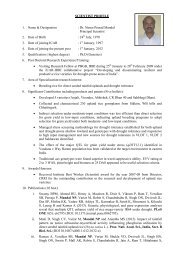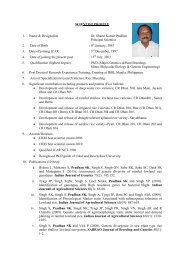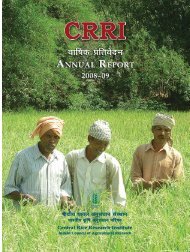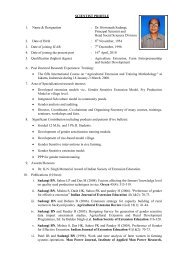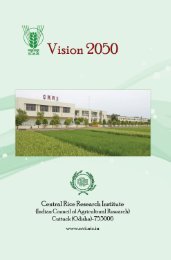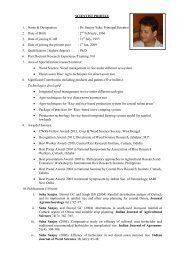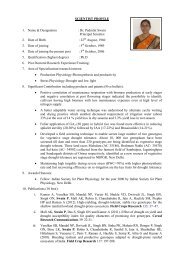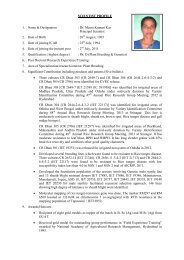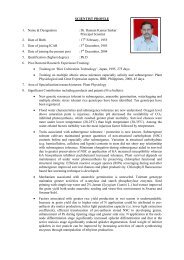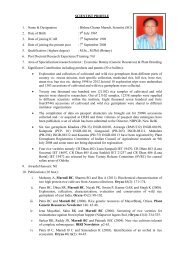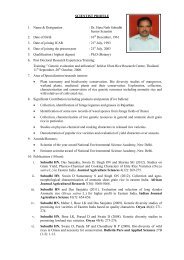Central Rice Research Institute Annual report...2011-12
Central Rice Research Institute Annual report...2011-12
Central Rice Research Institute Annual report...2011-12
You also want an ePaper? Increase the reach of your titles
YUMPU automatically turns print PDFs into web optimized ePapers that Google loves.
Table 46. Extent of adoption of CRRI rice varieties by the farmers<br />
Total rice Area under<br />
Name of Farmers adopted under area of the different<br />
Variety different categories (f) responders, varieties, Extent of<br />
Small Medium Large Total wet season wet season adoption in<br />
(n=58) (n=30) (n=<strong>12</strong>) (N=100) 2011 (ha) 2011(ha) terms of Area<br />
Pooja 36 (90.00) 48(92.31) 4 (50.00) 88 (88.00) 86.02 39.55 45.75%<br />
Sarala 28 (70.00) 48 (92.31) 8(100.00) 84(84.00) 34.59 40.21%<br />
Durga 4 (10.00) <strong>12</strong> (23.08) 8 (100.00) 24 (24.00) <strong>12</strong>.08 14.04%<br />
(Figures in the parentheses indicate percentage)<br />
appropriateness score three categories of appropriateness<br />
were developed viz., ‘very appropriate’ (score more<br />
than 2.4), ‘somewhat appropriate’ (score 1.8 – 2.4) and<br />
‘less appropriate’ (score less than 1.8).<br />
The data relating to the extent of adoption of CRRI<br />
rice varieties by the farmers revealed that majority (88%)<br />
of farmers adopted rice variety Pooja followed by Sarala<br />
(84%) and Durga (24%). The extent of adoption in terms<br />
of area was highest for Pooja (45.97%) followed by<br />
Sarala (40.21%) (Table 46).<br />
The findings on appropriateness of CRRI rice varieties<br />
revealed that rice variety Pooja was found to be<br />
most appropriate with score 2.83 among the three<br />
widely adopted lowland varieties as perceived by the<br />
rice growers (Table 47).<br />
Further analysis revealed that the rice variety Pooja<br />
was found to be ‘very appropriate’ as perceived by highest<br />
percentage of farmers (89) followed by 11% as ‘somewhat<br />
appropriate’. Regarding the perceived appropriateness<br />
of rice variety Sarala it was found to be ‘very<br />
appropriate’ by highest percentage of farmers (86)<br />
whereas, in case of rice variety Durga highest percentage<br />
(60) of farmers perceived it as ‘somewhat appropriate’<br />
for their land situation. The variety Pooja was found<br />
to be most appropriate CRRI variety as perceived by the<br />
farmers under study.<br />
Prediction of requirement of quality seeds of<br />
rice by the farmers of different ecosystems in<br />
India<br />
In the second phase, the study was conducted by<br />
gathering data on indirect preferences of farmers of<br />
Chhattisgarh and Jharkhand under different ecosystems<br />
for rice seeds.<br />
Chhattisgarh State<br />
During dry season, the single most preferred variety<br />
of rice by the farmers was MTU 1010. During wet<br />
season 2011-<strong>12</strong>, the preferred upland varieties of rice<br />
by the farmers of Chhattisgarh in decreasing order of<br />
Table 47. Appropriateness of CRRI rice varieties as<br />
perceived by the rice growers (N=100)<br />
Parameters of<br />
CRRI rice varieties<br />
Appropriateness<br />
Pooja Sarala Durga<br />
Social appropriateness 2.35 2.55 2.25<br />
Economic appropriateness 3.00 2.80 2.50<br />
Environmental appropriateness 3.00 2.75 2.35<br />
Technological appropriateness 3.00 2.80 2.45<br />
Total 2.83 2.72 2.38<br />
preference were MTU-1010, IR-36, Danteswari,<br />
Samaleswari, Narendra Dhan-97 and Poornima. The<br />
preferred medium land varieties of rice in decreasing<br />
order of preference were MTU-1001, Mahamaya, IR-<br />
64, Bamleshwari, HMT, KRH-2(Hybrid), Shatabdi,<br />
Tapaswini, Chandrahasini, Anjali, Indira Sona, Indira<br />
Sugandhit Dhan and Pusa Basmati-1. The lowland rice<br />
varieties in decreasing order of preference were MTU-<br />
7029, Karma Mahsuri, BPT-5204, MTU-1032, Kasturi,<br />
Mahsuri, BPT-3291 and Krishna Hamsa. CRRI rice varieties<br />
viz., Shatabdi, Tapaswini, Anjali were found to<br />
be prominent in the seed chain.<br />
Jharkhand State<br />
During dry season, out of 24 districts, rice was grown<br />
only in fourteen districts of Jharkhand. However, the<br />
preferred varieties in decreasing order of demand were<br />
IR-64, Naveen, MTU-7029, Rajender Mahsuri, MTU-<br />
1010 and IR-36. During wet season 2011-<strong>12</strong>, the upland<br />
varieties of rice by the farmers of Jharkhand in<br />
decreasing order of preference were Birsa dhan-108,<br />
Birsa Vikas-109, Birsa Vikas-110 and Vandana. The<br />
medium land varieties of rice in decreasing order of<br />
preference were IR-64, IR-36, Lalat, Naveen, MTU-1001,<br />
Abhisek, Sahabhagidhan and Hazaridhan. The preferred<br />
lowland rice varieties in decreasing order of preference<br />
were MTU-7029, Rajendar Mahsuri and MTU-<br />
1010. A good number of CRRI varieties viz., Naveen,<br />
Vandana, Abhishek, Sahabhagidhan and Hazaridhan<br />
were found in the seed chain of Jharkhand.<br />
94 CRRI ANNUAL REPORT 2011-<strong>12</strong>



